China Brands, Marketing & Consumers
NIKE vs ERKE: Two Sportswear Brands Trending on Weibo for Totally Different Reasons
While domestic brand Erke is all the hype, Nike is growing increasingly unpopular.
Published
3 years agoon
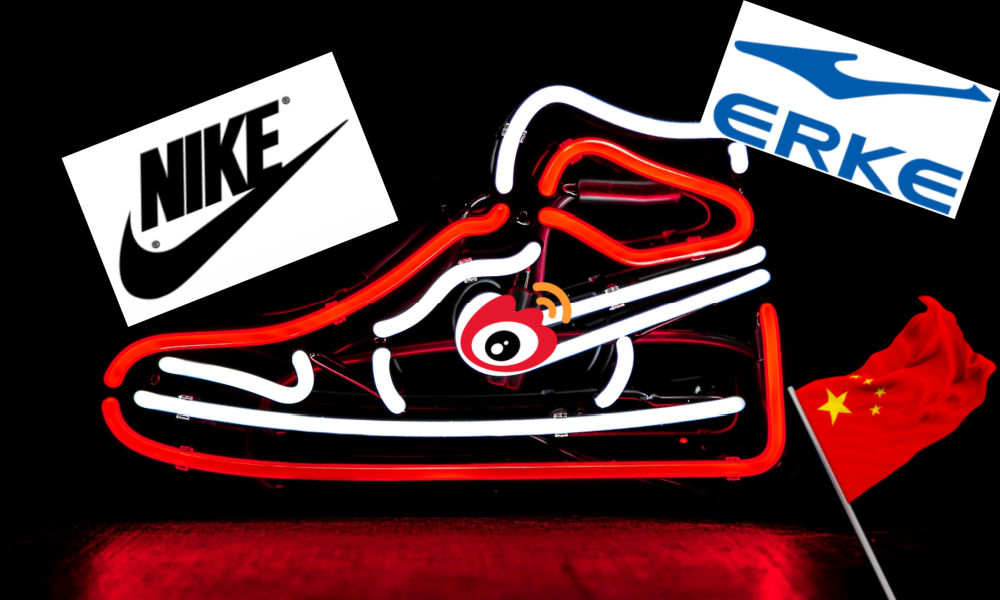
WHAT’S ON WEIBO ARCHIVE | PREMIUM CONTENT ARTICLE
Domestic sportswear company Erke has recently become a top-selling brand in China. The American sports brand Nike, on the other hand, has seemingly lost its reputation in the Chinese market. This week’s trending Weibo topics relating to the companies are telling of the ongoing battle between domestic and international sportswear brands in China.
American sportswear brand Nike and Chinese domestic sportswear brand Erke (鸿星尔克) both popped up in the Weibo trending lists this week, but for two totally different reasons.
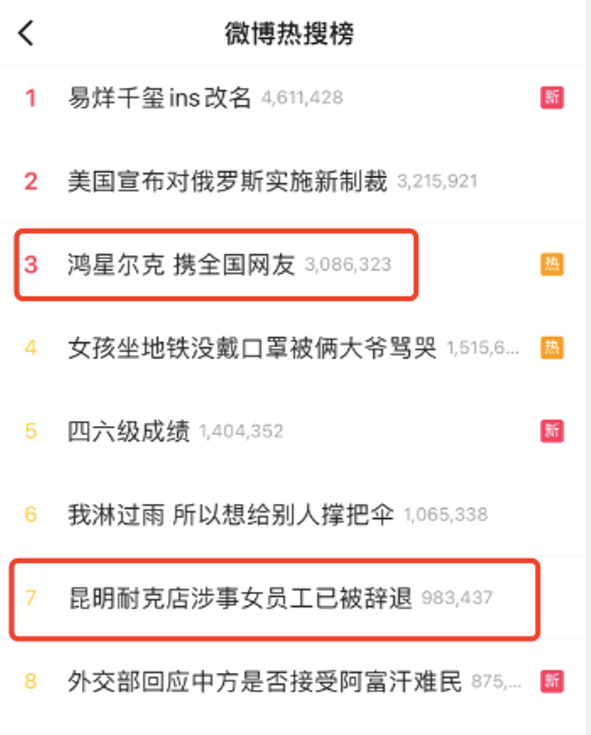
While Nike got caught up in controversy, Erke was praised. The stark contrast between how the two brands are represented on social media today is telling of their recent position in the Chinese market.
Nike Store Employee vs Chinese Migrant Worker
The trending incident involving Nike this week was about a bad shopping experience at the Nike store in Kunming, Yunnan province. On August 13, the 44-year old migrant worker Mao Zhigao (毛治高) took his three kids out shopping in the Nike store to reward them for their good school results.
What was supposed to be a fun family occasion turned into an awful afternoon when a female employee at the store reportedly snatched Nike clothes out of the hands of the youngest son and put them back on the hangers again.
When the boy tearfully told his parents about what happened, the incident soon escalated. The boy’s father, Mr. Mao, believed that the Nike employees were treating the family badly based on their appearance. As a migrant worker working on a construction site, Mao had just returned from work and was in his work clothes.
When the young boy’s mother confronted the employee about what had happened, the altercation apparently turned physical when the Nike employee started scratching and hair-pulling. Local police officers eventually stepped in to mediate.
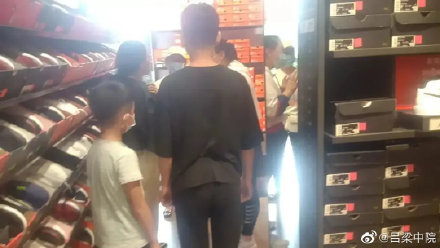
Although the Mao family demanded an apology from the Nike staff and also filed a complaint to Nike, they did not receive any reply. After six days, local media got involved and the story went trending.
Nike then responded to the issue with an apology and statement that the female employee was dismissed.
By Monday, August 23rd, some hashtags related to the incident received millions of views on Weibo:
- “Nike’s Kunming Store Responds to Suspected Discrimination of 9-Year-Old Boy” (#昆明耐克店回应男孩疑遭歧视#)- 8.29 million views.
- “Discriminated Rural Migrant Work Wants a Public Apology from Nike” (#遭歧视民工希望耐克公开道歉#) – 100 million views.
- “Employee Who Discriminated Rural Migrant Worker is Sacked” (#歧视农民工耐克店员被开除#) – 160 million views.
- “Female Employee Involved in Nike’s Kunming Store Incident Fired” (#昆明耐克店涉事女员工已被辞退#) – 140 million views.
On social media, the Nike incident was mostly viewed through the angle of unfair treatment and the international brand discriminating against a Chinese migrant worker.
Erke as ‘Patriotic Brand’
While Nike is being criticized, Erke, the Chinese sportswear brand by Hongxing Erke Group (鸿星尔克), is praised because it announced to donate one million yuan ($153,800) to Henan Museum to support the museum’s rebuilding project after the devastating flood.
A picture posted by Henan Museum on its Weibo account (@河南博物院) shows that Erke put the donation in the name of “national netizens.”
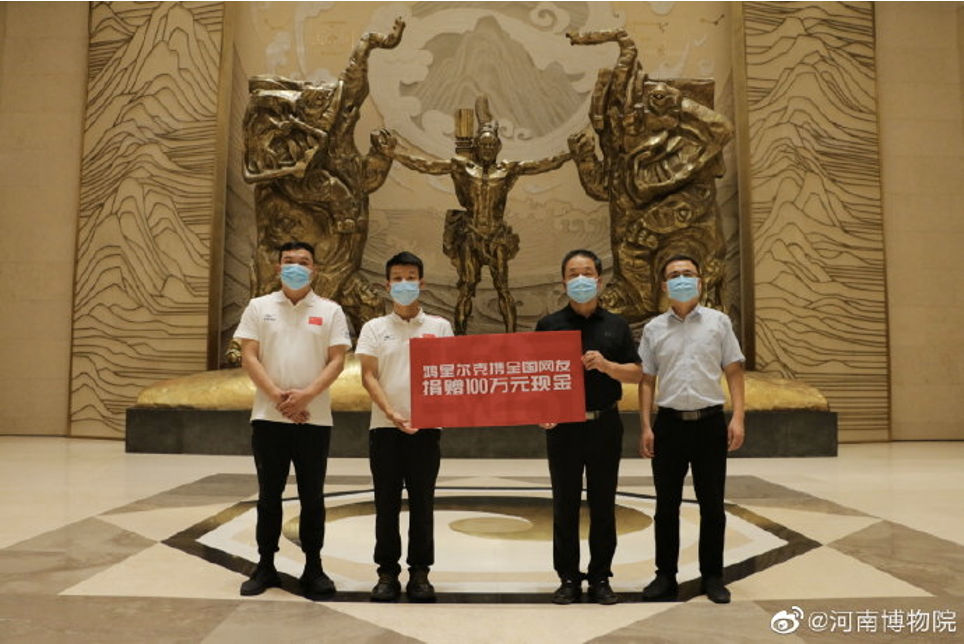
The picture soon went viral on Weibo, with the hashtag “ERKE Donates One Million Yuan to Henan Museum” (#鸿星尔克向河南博物院捐赠一百万元#) receiving 450 million views, and “ERKE Together With National Netizens” (#鸿星尔克 携全国网友#) receiving 140 million views.
This is the second time that Erke made a donation to help Henan in light of the floods. Its first donation in late July of this year is actually what helped the brand back into the limelight.
The domestic sportswear brand then donated 50 million yuan ($7.7 million) to the Henan flood. This attracted a lot of attention on Chinese social media since Erke was known as a relatively low-profile brand that seemingly has not been doing too well over the past years.
After people found out that the company donated such a high amount of money to help the people in Henan despite its own losses, its online sales went through the roof – everyone wanted to support this generous ‘patriotic brand.’ While netizens rushed to the online shops selling Erke, the brand’s physical shops also ran out of products with so many people coming to buy their sportswear. One female sales assistant was moved to tears when the store suddenly filled up with so many customers.
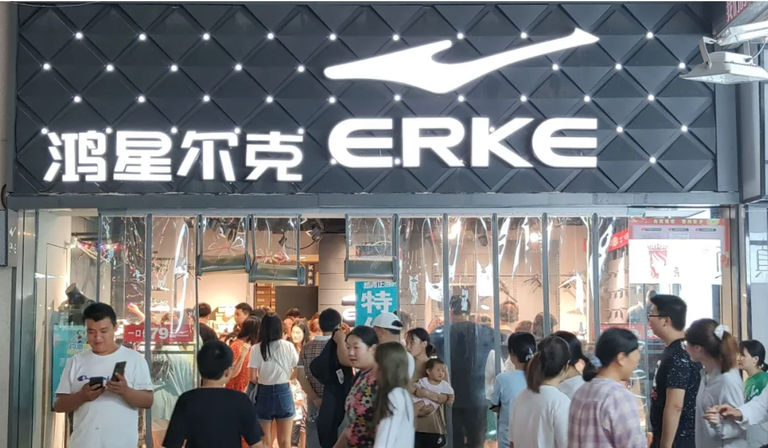
Image via Ellemen.
Lei Jun, the founder of the electronics company Xiaomi, also joined the Erke hype. He published a picture of him wearing Erke shoes on Weibo, the hashtag dedicated to this topic then received about 200 million views (#雷军晒鸿星尔克鞋#).
Consumer Nationalism and Sportswear Brands
It is not just Nike that has seemingly become less popular in China. Earlier this month, one hashtag about another global sports brand, Adidas, also went viral on Weibo. The trending hashtag was about the brand’s revenue growth of Q2 in China dropping by 16% (#阿迪达斯在华收入下跌16%#), receiving more than 110 million views.
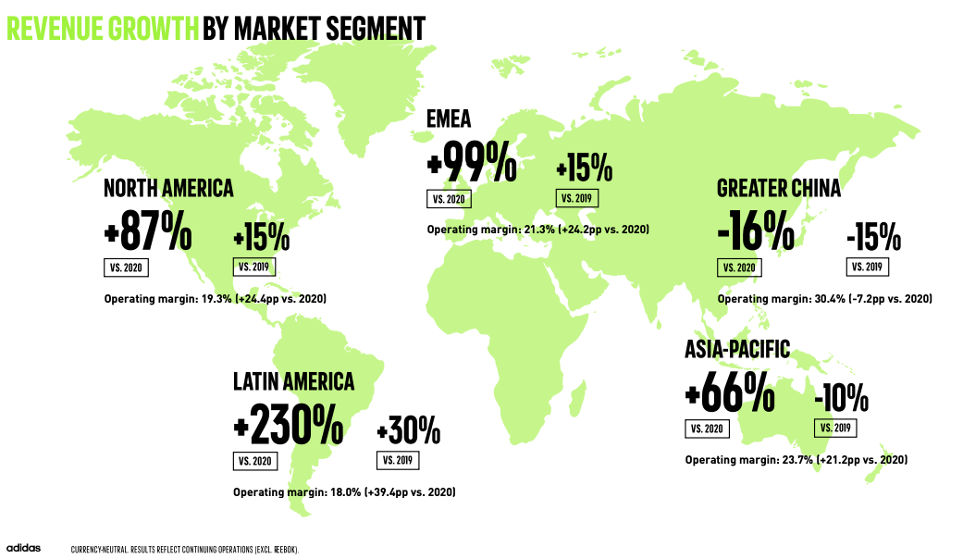
During its Q2 2021 conference call, in response to a question about the current consumer demands regarding global brands vs domestic brands in China, CEO of Adidas Group Kasper Rorsted said: “We continue to see a strong demand for products in China, [but] we believe right now that demand has been scooted towards Chinese local brands more than global brands.”
On August 24, news about the online sales of the Chinese Anta Sportswear brand topping those of Nike and Adidas received over 200 million views on Weibo alone (#安踏线上首超耐克阿迪#).

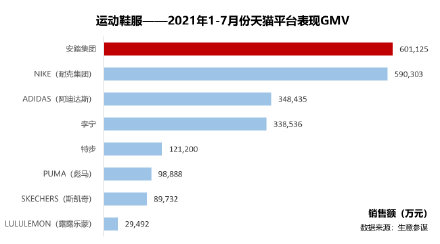
It seems that international sports brands have to look for new ways of winning over consumers in the Chinese market. This shift partly relates to two issues.
The first major issue that has impacted the popularity of brands such as Nike and Adidas has to do with the fact that they are members of the BCI (Better Cotton Initiative), which came under fire in China earlier this year after it had announced it would cease all field-level activities in the Xinjiang region with immediate effect due to concerns over the alleged use of forced labor.
The BCI ‘Xinjiang Cotton Ban’ led to an online ‘Xinjiang Cotton Support’ campaign in China. The BCI member brands boycotting Xinjiang cotton were soon labeled as being ‘anti-China.’ Chinese staff members at Nike and Adidas stores were scolded during live streams, and photos of people burning their Nike shoes soon started circulating on social media.
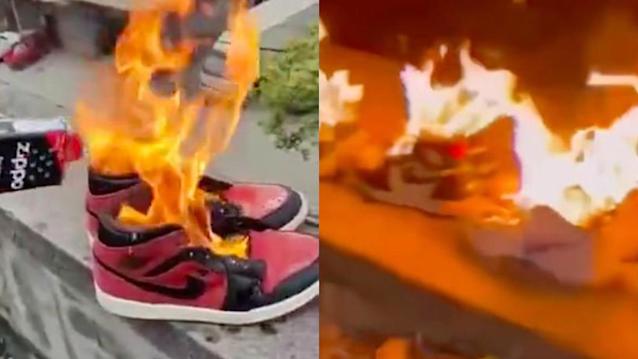
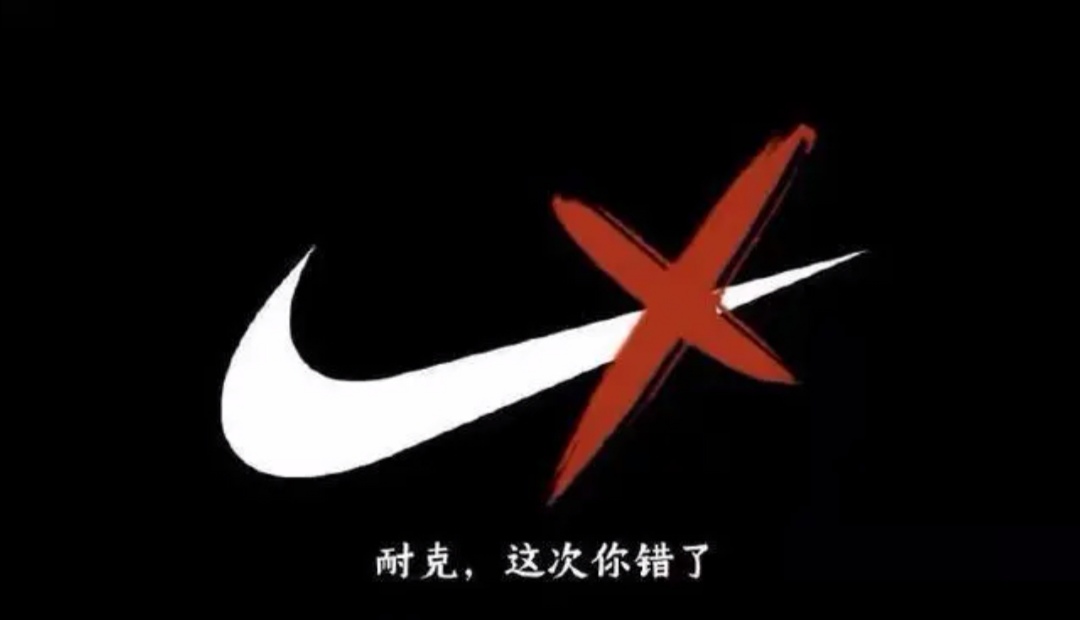
Another trend that has impacted the influence of foreign sportswear brands in China relates to the rise in popularity of local, Chinese sportswear brands. Domestic brands such as Anta Sports and Lining have been active in Chinese since the 1990s and are now profiting from changing consumer sentiments in a new era that is all about “proudly made in China.”
Besides incorporating more Chinese elements into their product design, Chinese celebrities also play a crucial role in the marketing of these domestic brands. Chinese actor and singer Xiao Zhan (肖战) was praised on social media for becoming the new brand ambassador of the Chinese sportswear brand Lining. When celebrity Wang Yibo became the spokesperson for the domestic brand Anta Sports, one Weibo hashtag page on the topic received over one billion views (#王一博代言安踏#) in late April of 2021. The promotional poster featuring Wang Yibo shows him wearing a t-shirt with “China” on it, including the national flag – profiling Anta as a ‘nation-loving brand.
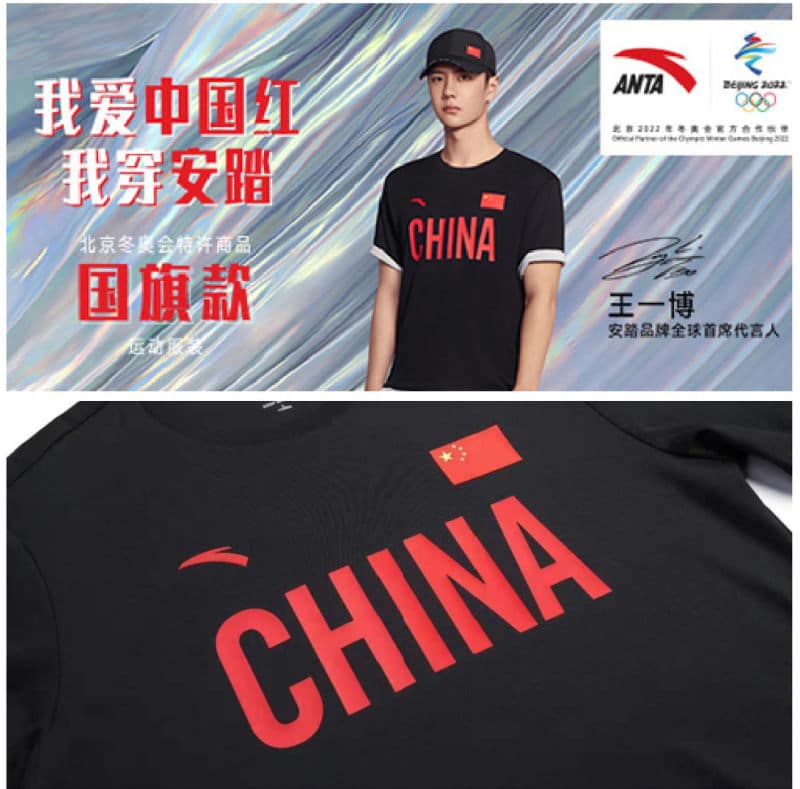
On social media, it already became clear earlier this year that a distinction was being made between foreign, ‘anti-Chinese’ brands, and domestic, ‘patriotic’ brands (read more here).
Erke indirectly profited from these existing consumer sentiments when, as a relatively smaller domestic brand, it was hyped as the no 1 patriotic sportswear brand for donating so much money to help out during the Henan floods.
Although Nike and Adidas each also contributed 20 million yuan ($3 million) toward Henan floods relief efforts, their donations barely received online attention. In fact, Nike was even condemned online for donating “zero yuan” at a time when it had already announced donating 20 million (more about that here).
The Erke hype even went so far that Chinese livestream sellers of Nike and Adidas notified their viewers that they actually supported the domestic Erke brand.
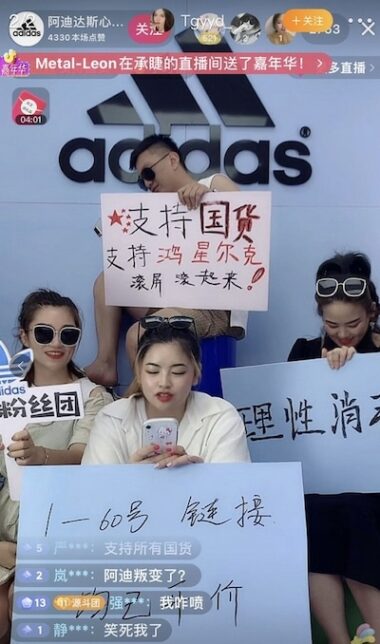
Adidas livestream sellers supporting Erke.
These nationalistic consumer sentiments also surfaced during the Olympics, when Chinese sport shooter Yang Qian was criticized for her collection of Nike shoes. One Beijing Television journalist wrote on social media: “Chinese athletes, why would you want to collect Nike shoes, shouldn’t you take the lead in boycotting Nike? Aren’t our domestic brands such as Erke, Li Ning, and Anta good enough [for you]?”
During the Tokyo Olympics, Team China’s podium uniform was designed by Chinese sportswear brand Anta, which will also be the Official Sportswear Uniform Supplier for the 2022 Winter Olympics.
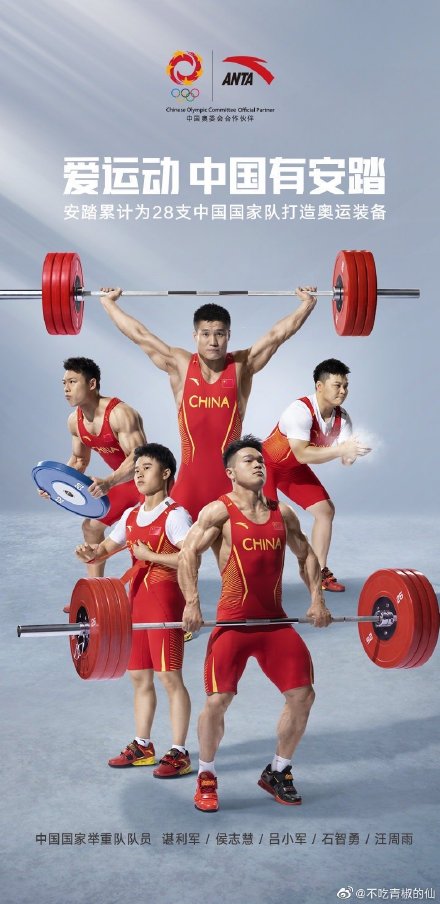
Anta x Olympics.
In light of everything that happened during the past few months, it is likely that for the time to come, domestic brands such as Erke will continue to flourish while foreign brands might see their China sales slump.
Meanwhile, on social media, netizens continue to express their support for domestic brands while denouncing Nike.
Multiple commenters wrote: “Erke is like ‘I’ve gotten wet, so I want to give others an umbrella too.’ Nike is like ‘Put down those clothes, your dad looks dirty, how you can afford to buy?'”
“I’ll support domestically produced products,” many others write: “Brands that are not patriotic should get out of the country.”
By Wendy Huang & Manya Koetse
Follow @whatsonweibo
Spotted a mistake or want to add something? Please let us know in comments below or email us. Please note that your comment below will need to be manually approved if you’re a first-time poster here.
©2021 Whatsonweibo. All rights reserved. Do not reproduce our content without permission – you can contact us at info@whatsonweibo.com
Stories that are authored by the What's on Weibo Team are the stories that multiple authors contributed to. Please check the names at the end of the articles to see who the authors are.

Also Read
China Books & Literature
Why Chinese Publishers Are Boycotting the 618 Shopping Festival
Bookworms love to get a good deal on books, but when the deals are too good, it can actually harm the publishing industry.
Published
2 months agoon
June 8, 2024By
Ruixin Zhang
JD.com’s 618 shopping festival is driving down book prices to such an extent that it has prompted a boycott by Chinese publishers, who are concerned about the financial sustainability of their industry.
When June begins, promotional campaigns for China’s 618 Online Shopping Festival suddenly appear everywhere—it’s hard to ignore.
The 618 Festival is a product of China’s booming e-commerce culture. Taking place annually on June 18th, it is China’s largest mid-year shopping carnival. While Alibaba’s “Singles’ Day” shopping festival has been taking place on November 11th since 2009, the 618 Festival was launched by another Chinese e-commerce giant, JD.com (京东), to celebrate the company’s anniversary, boost its sales, and increase its brand value.
By now, other e-commerce platforms such as Taobao and Pinduoduo have joined the 618 Festival, and it has turned into another major nationwide shopping spree event.
For many book lovers in China, 618 has become the perfect opportunity to stock up on books. In previous years, e-commerce platforms like JD.com and Dangdang (当当) would roll out tempting offers during the festival, such as “300 RMB ($41) off for every 500 RMB ($69) spent” or “50 RMB ($7) off for every 100 RMB ($13.8) spent.”
Starting in May, about a month before 618, the largest bookworm community group on the Douban platform, nicknamed “Buying Like Landsliding, Reading Like Silk Spinning” (买书如山倒,看书如抽丝), would start buzzing with activity, discussing book sales, comparing shopping lists, or sharing views about different issues.

Social media users share lists of which books to buy during the 618 shopping festivities.
This year, however, the mood within the group was different. Many members posted that before the 618 season began, books from various publishers were suddenly taken down from e-commerce platforms, disappearing from their online shopping carts. This unusual occurrence sparked discussions among book lovers, with speculations arising about a potential conflict between Chinese publishers and e-commerce platforms.
A joint statement posted in May provided clarity. According to Chinese media outlet The Paper (@澎湃新闻), eight publishers in Beijing and the Shanghai Publishing and Distribution Association, which represent 46 publishing units in Shanghai, issued a statement indicating they refuse to participate in this year’s 618 promotional campaign as proposed by JD.com.
The collective industry boycott has a clear motivation: during JD’s 618 promotional campaign, which offers all books at steep discounts (e.g., 60-70% off) for eight days, publishers lose money on each book sold. Meanwhile, JD.com continues to profit by forcing publishers to sell books at significantly reduced prices (e.g., 80% off). For many publishers, it is simply not sustainable to sell books at 20% of the original price.
One person who has openly spoken out against JD.com’s practices is Shen Haobo (沈浩波), founder and CEO of Chinese book publisher Motie Group (磨铁集团). Shen shared a post on WeChat Moments on May 31st, stating that Motie has completely stopped shipping to JD.com as it opposes the company’s low-price promotions. Shen said it felt like JD.com is “repeatedly rubbing our faces into the ground.”
Nevertheless, many netizens expressed confusion over the situation. Under the hashtag topic “Multiple Publishers Are Boycotting the 618 Book Promotions” (#多家出版社抵制618图书大促#), people complained about the relatively high cost of physical books.
With a single legitimate copy often costing 50-60 RMB ($7-$8.3), and children’s books often costing much more, many Chinese readers can only afford to buy books during big sales. They question the justification for these rising prices, as books used to be much more affordable.
Book blogger TaoLangGe (@陶朗歌) argues that for ordinary readers in China, the removal of discounted books is not good news. As consumers, most people are not concerned with the “life and death of the publishing industry” and naturally prefer cheaper books.
However, industry insiders argue that a “price war” on books may not truly benefit buyers in the end, as it is actually driving up the prices as a forced response to the frequent discount promotions by e-commerce platforms.
China News (@中国新闻网) interviewed publisher San Shi (三石), who noted that people’s expectations of book prices can be easily influenced by promotional activities, leading to a subconscious belief that purchasing books at such low prices is normal. Publishers, therefore, feel compelled to reduce costs and adopt price competition to attract buyers. However, the space for cost reduction in paper and printing is limited.
Eventually, this pressure could affect the quality and layout of books, including their binding, design, and editing. In the long run, if a vicious cycle develops, it would be detrimental to the production and publication of high-quality books, ultimately disappointing book lovers who will struggle to find the books they want, in the format they prefer.
This debate temporarily resolved with JD.com’s compromise. According to The Paper, JD.com has started to abandon its previous strategy of offering extreme discounts across all book categories. Publishers now have a certain degree of autonomy, able to decide the types of books and discount rates for platform promotions.
While most previously delisted books have returned for sale, JD.com’s silence on their official social media channels leaves people worried about the future of China’s publishing industry in an era dominated by e-commerce platforms, especially at a time when online shops and livestreamers keep competing over who has the best book deals, hyping up promotional campaigns like ‘9.9 RMB ($1.4) per book with free shipping’ to ‘1 RMB ($0.15) books.’
This year’s developments surrounding the publishing industry and 618 has led to some discussions that have created more awareness among Chinese consumers about the true price of books. “I was planning to bulk buy books this year,” one commenter wrote: “But then I looked at my bookshelf and saw that some of last year’s books haven’t even been unwrapped yet.”
Another commenter wrote: “Although I’m just an ordinary reader, I still feel very sad about this situation. It’s reasonable to say that lower prices are good for readers, but what I see is an unfavorable outlook for publishers and the book market. If this continues, no one will want to work in this industry, and for readers who do not like e-books and only prefer physical books, this is definitely not a good thing at all!”
By Ruixin Zhang, edited with further input by Manya Koetse
Independently reporting China trends for over a decade. Like what we do? Support us and get the story behind the hashtag by subscribing:
Spotted a mistake or want to add something? Please let us know in comments below or email us. First-time commenters, please be patient – we will have to manually approve your comment before it appears.
©2024 Whatsonweibo. All rights reserved. Do not reproduce our content without permission – you can contact us at info@whatsonweibo.com.
China Brands, Marketing & Consumers
Chinese Sun Protection Fashion: Move over Facekini, Here’s the Peek-a-Boo Polo
From facekini to no-face hoodie: China’s anti-tan fashion continues to evolve.
Published
2 months agoon
June 6, 2024
It has been ten years since the Chinese “facekini”—a head garment worn by Chinese ‘aunties’ at the beach or swimming pool to prevent sunburn—went international.
Although the facekini’s debut in French fashion magazines did not lead to an international craze, it did turn the term “facekini” (脸基尼), coined in 2012, into an internationally recognized word.
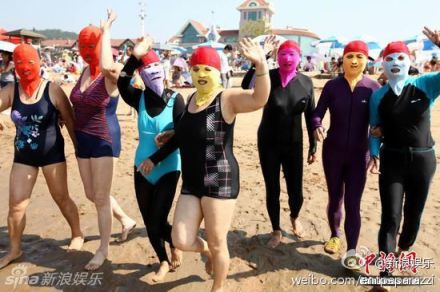
The facekini went viral in 2014.
In recent years, China has seen a rise in anti-tan, sun-protection garments. More than just preventing sunburn, these garments aim to prevent any tanning at all, helping Chinese women—and some men—maintain as pale a complexion as possible, as fair skin is deemed aesthetically ideal.
As temperatures are soaring across China, online fashion stores on Taobao and other platforms are offering all kinds of fashion solutions to prevent the skin, mainly the face, from being exposed to the sun.

One of these solutions is the reversed no-face sun protection hoodie, or the ‘peek-a-boo polo,’ a dress shirt with a reverse hoodie featuring eye holes and a zipper for the mouth area.

This sun-protective garment is available in various sizes and models, with some inspired by or made by the Japanese NOTHOMME brand. These garments can be worn in two ways—hoodie front or hoodie back. Prices range from 100 to 280 yuan ($13-$38) per shirt/jacket.

The no-face hoodie sun protection shirt is sold in various colors and variations on Chinese e-commerce sites.
Some shops on Taobao joke about the extreme sun-protective fashion, writing: “During the day, you don’t know which one is your wife. At night they’ll return to normal and you’ll see it’s your wife.”

On Xiaohongshu, fashion commenters note how Chinese sun protective clothing has become more extreme over the past few years, with “sunburn protection warriors” (防晒战士) thinking of all kinds of solutions to avoid a tan.

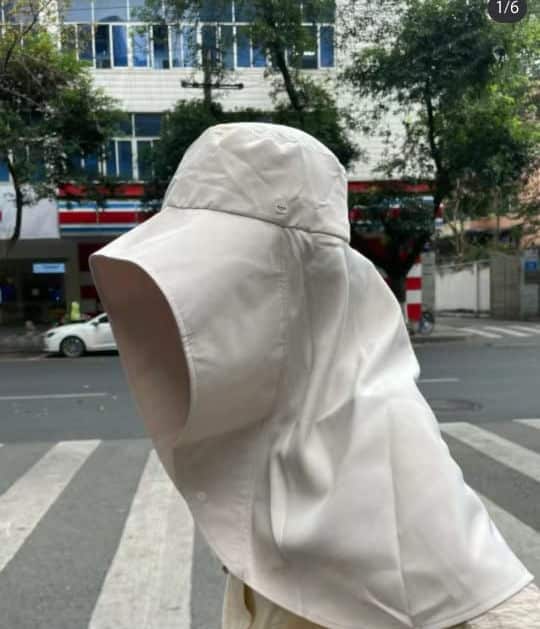


Although there are many jokes surrounding China’s “sun protection warriors,” some people believe they are taking it too far, even comparing them to Muslim women dressed in burqas.
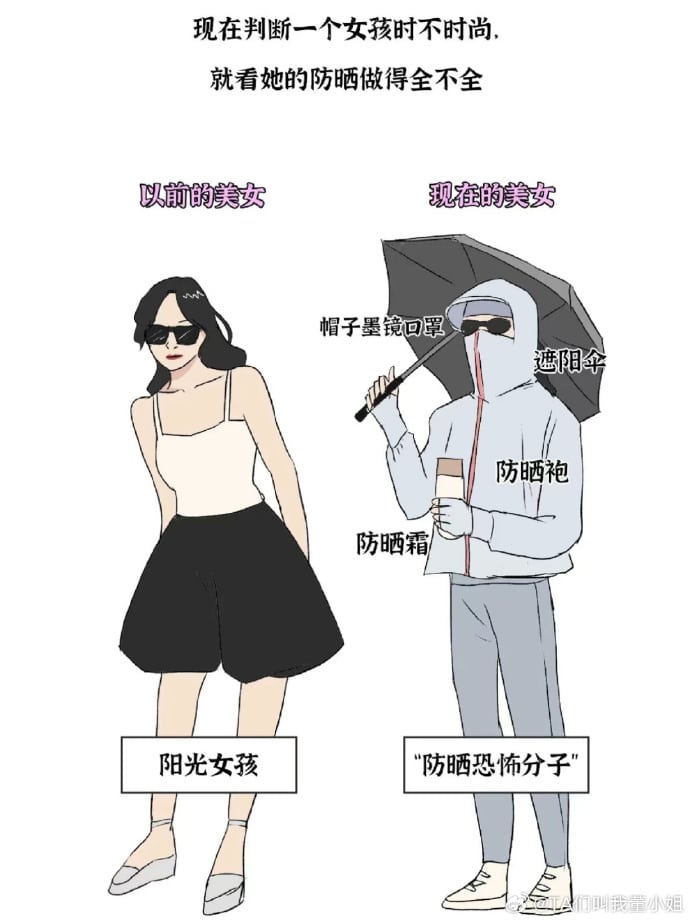
Image shared on Weibo by @TA们叫我董小姐, comparing pretty girls before (left) and nowadays (right), also labeled “sunscreen terrorists.”
Some Xiaohongshu influencers argue that instead of wrapping themselves up like mummies, people should pay more attention to the UV index, suggesting that applying sunscreen and using a parasol or hat usually offers enough protection.
By Manya Koetse, with contributions by Miranda Barnes
Spotted a mistake or want to add something? Please let us know in comments below or email us. First-time commenters, please be patient – we will have to manually approve your comment before it appears.
©2024 Whatsonweibo. All rights reserved. Do not reproduce our content without permission – you can contact us at info@whatsonweibo.com.
Subscribe

Weibo Watch: The Future is Here

“Bye Bye Biden”: Biden’s Many Nicknames in Chinese

Enjoying the ‘Sea’ in Beijing’s Ditan Park

A Triumph for “Comrade Trump”: Chinese Social Media Reactions to Trump Rally Shooting

Weibo Watch: Get Up, Stand Up

The Tragic Story of “Fat Cat”: How a Chinese Gamer’s Suicide Went Viral

“Old Bull Eating Young Grass”: 86-Year-Old Chinese Painter Fan Zeng Marries 36-Year-Old Xu Meng

A Brew of Controversy: Lu Xun and LELECHA’s ‘Smoky’ Oolong Tea

Singing Competition or Patriotic Fight? Hunan TV’s ‘Singer 2024’ Stirs Nationalistic Sentiments

Zara Dress Goes Viral in China for Resemblance to Haidilao Apron

Weibo Watch: The Battle for the Bottom Bed

About the “AI Chatbot Based on Xi Jinping” Story

China’s Intensified Social Media Propaganda: “Taiwan Must Return to Motherland”

Weibo Watch: Telling China’s Stories Wrong

Saying Goodbye to “Uncle Wang”: Wang Wenbin Becomes Chinese Ambassador to Cambodia
Get in touch
Would you like to become a contributor, or do you have any tips or suggestions? Get in touch here!
Popular Reads
-

 China Insight3 months ago
China Insight3 months agoThe Tragic Story of “Fat Cat”: How a Chinese Gamer’s Suicide Went Viral
-

 China Music4 months ago
China Music4 months agoThe Chinese Viral TikTok Song Explained (No, It’s Not About Samsung)
-

 China Digital10 months ago
China Digital10 months agoToo Sexy for Weibo? Online Discussions on the Concept of ‘Cābiān’
-

 China Arts & Entertainment12 months ago
China Arts & Entertainment12 months agoBehind 8 Billion Streams: Who is Dao Lang Cursing in the Chinese Hit Song ‘Luocha Kingdom’?




